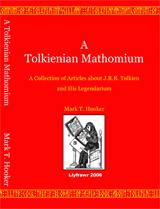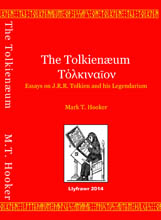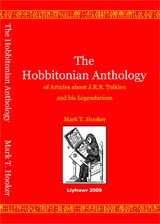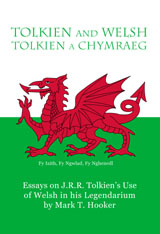|
From the Preface
Also by this author: 
|
This monograph is a collection of analytic essays on J.R.R. Tolkien's The Lord of the Rings and The Hobbit, written by Tolkien scholar and Comparative Translationist Mark T. Hooker, most famous, perhaps, for his application of Comparative Translation to the study of Tolkien in his book Tolkien Through Russian Eyes. All of the articles in the book have been reviewed and revised to take into consideration the materials available in The History of Middle-earth. Beware of Pirated PDF Copies of The Tolkienaeum WebPages that purport to be “eBookTreasures” or "eBook Universe" are offering a free PDF download of The Tolkienaeum. This is a pirated copy, and is not authorized by me, or by Llyfrawr. There is a legitimate platform called “eBookTreasures.” It is run by Armadillo Systems in cooperation with such prominent institutions as The British Library, Natural History Museum, and The John Rylands Library. This platform is intended to put the greatest books in the world into the hands of readers. eBooks in this series are available for download from the iBookstore; as an app on iTunes; in the Windows Store under “Books and Reference”; and selected titles are also available for Kindle Fire. Please do not confuse the one with the other. The same thing happened to J.R.R. Tolkien in 1965, when ACE Books brought out an unauthorized paperback edition of The Lord of the Rings. Tolkien’s publishers quickly countered with an authorized American edition, each copy of which bore a message from Tolkien that said: “This paperback edition and no other has been published with my consent and cooperation. Those who approve of courtesy (at least) to living authors will purchase it and no other.” To paraphrase Tolkien: Only the Llyfrawr paperback edition of The Tolkienaeum is published with my consent and cooperation. Those who approve of courtesy (at least) to living authors will purchase it and not download the PDF. In a way, having your book pirated makes you feel like you've arrived. Someone thought it was worth enough to go to the trouble of stealing it. If you have to have your book pirated, at least you're in good company with Tolkien in that regards. From the Preface:The Tolkienæum (Τόλκιναῖον) is the fourth volume in a series on J.R.R. Tolkien’s Legendarium by Tolkien researcher Mark T. Hooker, laureate of the Fifth Beyond Bree Award. The essays range from Tolkien’s probable literary sources, to his historical allusions; from his philological jests, to his serious linguistics. They take a linguistic perspective that begins with a name or a word, and looks for its story in the real world with which Tolkien was familiar. That is the essence of Tolkiennymy, a branch of Tolkien linguistics for which Hooker coined the name. The opening essay explores the similarities between the plot elements in Jules Verne’s classic A Journey to the Centre of the Earth (1864) and those in The Hobbit (1937). The Battle of Agincourt (1415) and the role that archers played in it are a part of the English mental legacy. It is discussed as the parallel to the Battle of Fornost to which the Hobbits sent bowmen.The cultural significance of a pocket-handkerchief in nineteenth-century England is the subject of one essay, while the natural history of the thrush is considered in another. The legal import of the period of a year and a day is discussed in a third. The puns in the names Smallburrow and Tuckborough are considered in yet two others. The series of essays in search of a source for the word Hobbit that was published in Beyond Bree has been expanded for this volume. Tolkien commented that his Legendarium was “fundamentally linguistic in inspiration.” In Tolkien’s creative process, a name came first and the story of the name followed. Tolkien also noted that he liked history and was moved by it, especially such history as “throws light on words and names.” The linguistic essays, therefore, look for the stories behind the names as well as for the semantics, and morphology. Tolkien would certainly have wanted the story to be told in addition to the gloss.
|
What makes this series of books different from others about Tolkien is that its author is a linguist who shares Tolkien’s appreciation of the histories of words and names, and who plays at the same kind of linguistic invention himself. Though the essays about Tolkien’s linguistic creations in The Tolkienæum are by a linguist, they were written with the non-linguist in mind in an effort to make the topic accessible to a larger audience. The unavoidable jargon of the field is explained in a glossary, and the narrative constructs a methodical and transparent overview of how Tolkien’s synthetic languages fit into the big picture of linguistics.
A special feature of the second half of this volume is Tolkien’s understanding and use of Proto-Indo-European asterisk forms. The essay on the Tolkiennym for wolf, for example, reveals a PIE root that has lurked unrecognized in The Etymologies. Highlighting it, and explaining its meaning make it possible to comprehend not only the trick that Tolkien is playing, but also the linguistic skill required to do it.
Tolkien’s extensive knowledge of mytho-linguistic issues is explored in an essay that compares Tolkien’s linguistic creations with the concept of animate-inanimate doublets developed by the prominent French linguist Antoine Meillet (1866-1936), who observed that the earlier forms of the Indo-European languages had doublet, animate-inanimate names for things like fire and water. Though there is no mention of Meillet in Tolkien’s writings, there are Tolkiennyms that clearly replicate Meillet’s linguistic model of doublets.
There are separate essays that focus specifically on Tolkien’s use of Slavic and Finnish roots in his nomenclature. Though there are essays on Tolkiennyms that are based on Welsh roots, there is no separate, specifically Welsh essay. That was the topic of the previous volume in this series: Tolkien and Welsh (Tolkien a Chymraeg).
One of the new essays presents an etymology for the surname Gamgee. Tolkien did say, after all, that “many ‘English’ surnames, ranging from the rarest to the most familiar, are linguistically derived from Welsh (or British), from place-names, patronymics, personal names, or nick-names; or are in part so derived, even when that origin is no longer obvious.” This is one of those cases.
Linguistic invention is a product of the mind, and is, therefore, not governed by the fixed and immutable rules of the sciences. As Albert Einstein once said, imagination is greater than knowledge. Since Tolkien is no longer with us, no “proof”—in the scientific sense—of the analyses presented in this volume is possible. The facts, therefore, must speak for themselves when no corroboration is possible.
This book combines both previously published and unpublished essays, to bring together the author’s work in one convenient volume. Many of the previously published essays have been especially revised and expanded for this project.
Includes bibliographic references and index. B&W illustrations.
Pagination: xxx + 258. Trade Paper $14.95
In keeping with tradition, James Dunning contributed the frontispiece for this volume. Journey to the Center of Middle-earth – An intrepid hairy-footed Hobbit with expeditionary supplies, a walking stick and a long rope pauses at the brink of a deep, deep hole indicated by the finger of the shadow of Scartaris. But wait, it’s awfully black down there! And Ruhmkorff lamps will not be invented for several millennia yet. Perhaps he can find a decent Wizard who will lend him his phosphorescent or luminescent staff and give him lessons how to use it. Inquiries about acquiring full-sized reproductions of this and the other drawings suitable for framing may be addressed to the artist via his site at dolmentree.com.
To learn more about the book, follow the links below.



